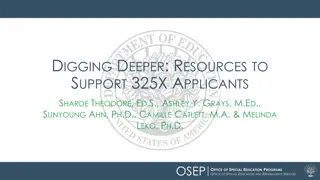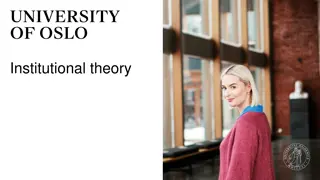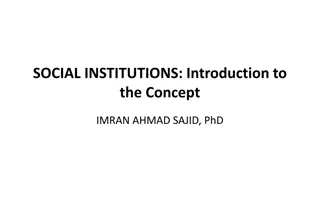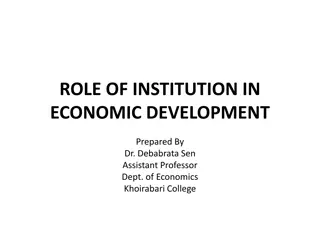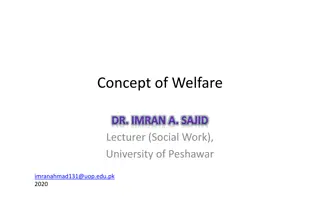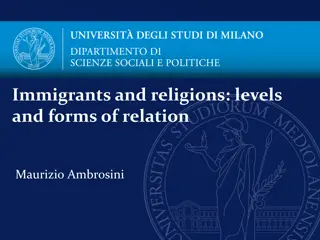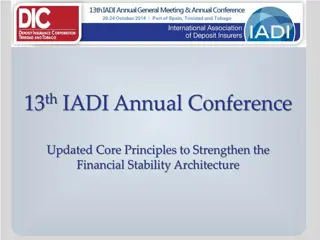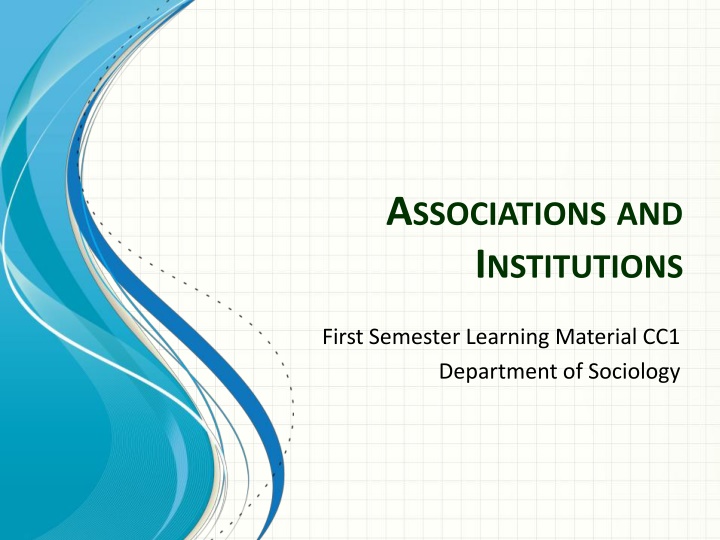
Associations and Institutions in Sociology
Delve into the world of associations and institutions in sociology with a focus on their definitions, characteristics, and importance. Explore how associations play a vital role in promoting specific interests in our society and learn about the distinctive features of these organized groups.
Download Presentation

Please find below an Image/Link to download the presentation.
The content on the website is provided AS IS for your information and personal use only. It may not be sold, licensed, or shared on other websites without obtaining consent from the author. If you encounter any issues during the download, it is possible that the publisher has removed the file from their server.
You are allowed to download the files provided on this website for personal or commercial use, subject to the condition that they are used lawfully. All files are the property of their respective owners.
The content on the website is provided AS IS for your information and personal use only. It may not be sold, licensed, or shared on other websites without obtaining consent from the author.
E N D
Presentation Transcript
ASSOCIATIONS AND INSTITUTIONS First Semester Learning Material CC1 Department of Sociology
Association Introduction Definition Characteristics of Associations Associations as a means of pursuing ends Associations as agencies and their corporate character The classification of associations Conclusion Institution Introduction Definition Characteristics of institutions Some of the important social institutions Conclusion
Associations Introduction Social interaction among human beings is necessary to the transmission of culture and the survival of every society. The most important feature of modern complex societies is associations, which are organized to promote specific interests. It is almost impossible to exaggerate the importance of association in the society in which we live and we all belong to many associations.
Definition An association is a group of people organized for a particular purpose or a number of purposes. According to MacIver and Page, an association is a group organised for the pursuit of an interest or group of interests in common (MacIver and Page 1950:12). In reality, associations are agencies whose major task is to promote awareness and solidarity among members of a collectivity to achieve some goals.
Characteristics Bierstedt has given some distinctiive characteristics of an association. They are as follows: (Bierstedt 1957:305, 312). 1. A specific function- every association is formed for the pursuit of a particular interest or activity for example a football association. 2. Associational norms every association has a set of norms which the members must follow and a specific to each association. 3. Authoritystructure every association has a structure of authority. Every member occupies a particular position and perform the roles attached to their status.
4. Voluntary membership- there is a test of membership for every association. Members must have certain qualifications if they seek to be a member. 5. A name and identifying symbols- an organisation is a formally organizes named group whch can be identified by a symbol that the members adopt. 6. Not profit oriented- the members of an asociation are not financially recompensed for their participation. Whatever money is raised is used for the betterment of the association. 7. Property almost all associations have property of their own.
Associations as a means of pursuing ends They act independently but this has many limitations. They seek them through conflict and competition with one another. Each striving to wrest the prize that they seek from the other. Men may pursue their ends in groups and in company, on some co- operative basis to pursue some common interest. 1 2 3
Associations as agencies and their corporate character Associations are agencies through which members seek to realize their shared interests. It has a method of operation peculiar to it as an association. It has funds which the members cannot at pleasure use for themselves. A public utility, a trade union, a political party, a club, a church is a unity and it is in this sense that an association has a corporate character when legal recognition is made of its organisation.
Classification of associations Generally associations are classified according to the interest protected by them According to MacIver and Page all associations can be classified into specialised and non- specialised. Specialised found in complex societies and stands for a particular type of interest. They have specific limited functional character. They take the form of economic groups, professional or political or cultural groups. Non specialised- found in primitive societies where there were fewer associations and were more diffudes in their interests and were more inclusive. They were communal or semi- communal in nature. They include forms as age-groups, kin groups, gender groups, etc.
Conclusion An association may have a great deal of power, which its individual members acting alone could not hope to possess and it is able to operate in a distinctive way, different from that in which its members operate. It is a group of people who voluntary come together and organize themselves for the pursuit of some common interest or goal.
Institutions Introduction Institutions are recognized and established rules of behaviour which govern how social relationships are organized. It is a system of beliefs, norms, values, positions and activities that develop around a basic societal need. Some of the important social institutions are economic institution, family, marriage, kinship, polity religion etc.
Definitions MacIver and Page defines social institutions as established forms or conditions of procedure characteristic of group activity. C. A. Ellwood has defined social Institutions as the habitual ways of living together which have been sanctioned, systematized and established by the communities. authorities of
Characteristics They are social in nature. They come into being due to the collective activities of people. Institutions are universally found. They are standardized procedures and norms. They prescribe the ways of doing things. Institutions act as a means of social control. It regulates the conduct of people in society. They function to fulfill the needs of human beings. They are relatively stable and permanent in nature.
Some of the important social institutions Economic institutions If we look at the social life of a local community we can observe a certain sum total of activities carried out by the persons who compose it. We can also observe a certain division of labour. These activities provide some sort of gratification for the person carrying out the activity but also for others. For example when a man goes out hunting, he provides meat not only for himself but also for his family and relatives. This system works through some social machinery which is economic- which may be simple or complex.
Kinship system It is the pattern of relationships that are organized around family relations. Social relations and interactions are based on relations (blood or affinal). Rules of descent go back to kinship system. Thus kinship systems establish relationships between individuals based on blood or marriage ties and determine modes of inheritance and interaction in terms of rights and obligations. It determines whom one can marry and whom one cannot marry.
Conclusion Social institution is a conceptual framework of how social relationships are conducted. It is a mechanism by which social structure is maintained, its existence and continuity. They are universally found in all human societies and functions to fulfill societal needs.
Reference Horton, Paul B., Chester L. Hunt. 2004, Sociology. New Delhi: Tata McGraw Hill, Chapter 9, Pp. 210-229
Expected Questions Bring out the difference between Institutions and Associations. Define a social institution. What are important characteristics of an institution? Elaborate the functions of an institution giving examples. What are the basic features of an association? Give examples.
Previous Years Questions Give examples af any two associations. Write any two differences between associations and institutions. Briefly define the role of family as an institution.



